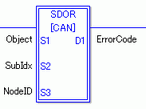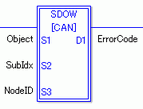
For more information regarding each operand, please refer to the following.
 30.7.4 Using I/O Driver Instructions - CANopen
30.7.4 Using I/O Driver Instructions - CANopen
The following describes the specifiable content of Operands (S1 to S10 and D1 to D5).
The number of steps in I/O Driver instructions depends on the specification method and the number of operands used. The following describes how to calculate the number of steps.
3 + Number of steps in operand S1 + ... + Number of steps in operand S10 + Number of steps in operand D1 + ... + Number of steps in operand D5 = Total number of steps in one instruction

For more information regarding each operand, please refer to the following. 30.7.4 Using I/O Driver Instructions - CANopen
30.7.4 Using I/O Driver Instructions - CANopen
Explanation of SDOR, SDOW, DGMT and DGSL Instructions
(For the number of steps in an operand, refer to the operand settings as follows.)
SDOR

3 Steps + {Object = 1 Step} + {SubIdx = 1 Step} + {NodeID = 1 Step} + {Length = 1 Step} + {Offset = 1 Step} + {ErrorCode = 1 Step} = 9 Steps
SDOW

3 Steps + {Object = 1 Step} + {SubIdx = 1 Step} + {NodeID = 1 Step} + {Length = 1 Step} + {Offset = 1 Step} + {ErrorCode = 1 Step} = 9 Steps
DGMT

3 Steps + {Status = 1 Step} + {Event = 1 Step} = 5 Steps
DGSL

3 Steps + {NodeID = 1 Step} + {Diagnostics = 1 Step} = 5 Steps
The first three steps are the number of steps required by all I/O Driver Instructions. Be sure to add these three steps for I/O Driver Instructions.